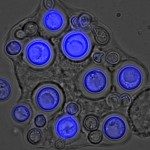Link to Pubmed [PMID] – 8586717
J. Clin. Microbiol. 1995 Dec;33(12):3278-83
We investigated a cluster of cases of Candida septicemia diagnosed in four burn patients. Twenty clinical isolates of Candida albicans and two of Candida parapsilosis, plus eight isolates of C. albicans recovered from nurses’ clothes, were analyzed by antifungal susceptibility testing and three genotyping methods (restriction fragment length polymorphism analysis with EcoRI and HinfI, arbitrarily primed PCR, and karyotyping). The high MICs of the azoles for all of the C. albicans isolates tested suggest either a natural resistance of the endogenous flora or the transmission of isolates with acquired resistance. The genotyping methods demonstrated the involvement of four different strains, cross-infections with one C. albicans strain and one C. parapsilosis strain, and identity between some of the strains from the patients and nurses. The origins of the strains remain unclear. Our results show that the use of a combination of at least two different methods such as those used in the present study is recommended for C. albicans typing.

